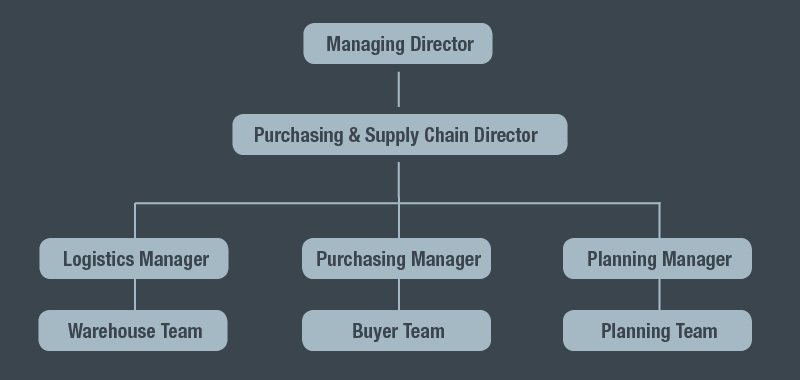The way your team is structured and managed can mean the difference between happy, returning customers and angry reviews or a bad reputation. In more progressive businesses, procurement, supply chain, operations, and sales teams are aligned. When the structure works well, processes are seamless which results in high levels of customer satisfaction, lower cost delivery to customers, and more sustainable output for all teams involved.
In a poorly organised function, a number of issues can arise. For example, if the finance team isn’t working closely with purchasing, and suppliers aren’t paid on time, the brand reputation suffers. If this happens, production may stop, which in turn, might mean that long-term supplier partnerships become very unlikely. In addition to this, if the sales function isn’t aligned with the supply chain, with regards to forecast, customers may be let down, and worse still this business may be lost altogether. Unfortunately, there are many negatives to getting it wrong dependant on the structure and also culture of your organisation.
So, how should a procurement and supply chain function be structured in order to operate most efficiently?
Don’t make these mistakes
The structure of procurement and supply functions within a business can have a positive impact on the bottom line and ultimately ensures repeat business. Additional benefits include improved employee retention, and being viewed as a progressive business and an employer of choice.
It is critical that procurement and supply chain functions have representation at main board level, or at the very least, a competent sponsor that understands the complexity and impact of a supply chain. In terms of the structure of the function, it is crucial to avoid the following key mistakes.
- A setup whereby planning reports into operations, as this creates a biased view on priorities.
- A structure that has purchasing reporting into finance, as this usually results in too much focus on purchase price rather than total cost.
- A lack of senior representation in S&OP meetings.
- Hiring the wrong skill sets. It is crucial to ensure that you have the right level of capability in the structure, P&SC should be a critical strategic function that can positively influence the whole order to cash cycle.
Structuring your team to drive productivity and efficiency
Considering the impact that the structure of your team can have on the success of your business, it should be a priority to ensure that your procurement and supply chain functions are structured correctly. A good place to start is to assess whether or not it is operating most efficiently.
- Conduct an internal survey of stakeholders.
- Ask their suppliers.
- Ask their customer for feedback.
- Ask a P&SC Interim consultant to conduct a health check.
A well-structured procurement and supply chain function will look different in each business. It will be determined by the product, service, scale, and delivery model to customer. As a basic manufacturing model, the logistics, purchasing and planning managers should report into the purchasing and supply chain director. This will ensure that respective teams are aligned and are working towards a common goal.

In an SME, sales/marketing, operations, and finance would sit alongside the purchasing and supply chain director. Regular communication is critical and can be facilitated by a structured format such as in an S&OP meeting, NPD project meetings, or a more casual engagement by ensuring the office layout and behaviours encourage collaboration.
Supply Chain Transformation Consultant and Senior Interim Leader, Mike Keen, highlighted that strong leadership is key in any structure. In order to move towards a more customer-centric and strategic value chain, Mike explained that the structure needs clear, functional levels to promote effective communication and build operational strength. "Middle management or sub-functional levels in your procurement and supply chain function not only ensure that there is an appropriate level of expertise guiding each team, but also forms the foundation of a development or succession path for your people.”
In order to build the right structure, you must ensure that the right technology is in place, roles and responsibilities are clearly defined, you are able to run a cross-function training programme, and that you create a culture that encourages learning and development.
People can make or break a team
The structure of your procurement and supply chain functions forms the starting point to a team that engages in effective communication, however, the people are mission critical. If the professionals that are in your team show the wrong behaviours for your business, do not collaborate, or empire build, it doesn’t matter how good your structure is.
Diverse and inclusive workforces contribute to the level of innovation within a team and how progressive the function will be. Essentially, there is no such thing a perfect structure, based on technology, customer requirements, and political changes, a great supply chain will always have to evolve in order to serve the needs of the business and customer. In the most successful businesses, supply chain is always at the forefront.
At Michael Page, we are experts in the sectors and local markets we recruit within. We take the time to understand our clients’ needs and meet with shortlisted candidates to ensure a great fit.
If you would like to discuss how we can help find the right people to drive your business forward, get in touch for a confidential discussion today.
Jonathan Weller
Senior Manager, Michael Page Procurement, Supply Chain, and Logistics
T: +44 161 829 0388